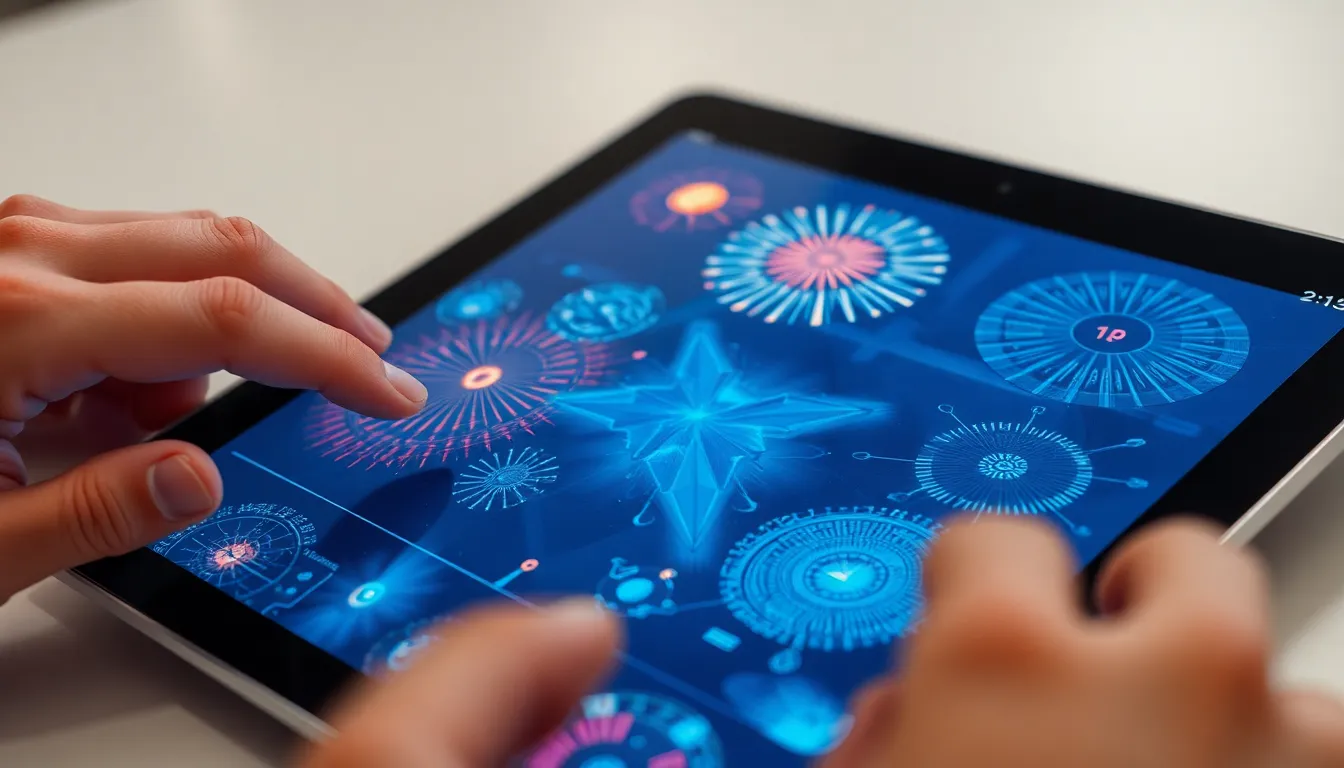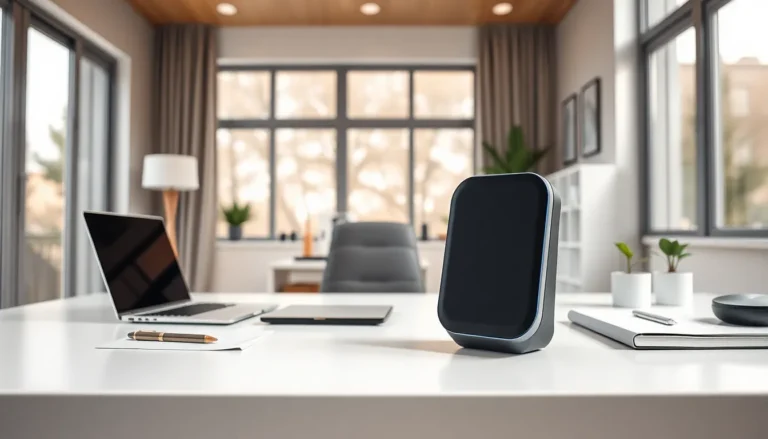Imagine tapping away on your tablet, and suddenly it feels like you’re playing a game of virtual whack-a-mole. That’s the magic of tablet haptics. These tiny vibrations and feedback mechanisms transform a mundane touch into a sensory experience, making users feel more connected to their devices. It’s like giving your tablet a personality—one that responds to your every swipe and pinch with a delightful buzz.
Table of Contents
ToggleOverview Of Tablet Haptics
Tablet haptics enhances user interaction by delivering tactile feedback through vibrations. This technology turns simple touch gestures into immersive experiences, strengthening the connection users feel with their devices.
Definition And Importance
Tablet haptics refers to the technology that provides tactile feedback to users during interactions with touchscreen devices. It plays a crucial role in improving user experience by making touch gestures feel more responsive and intuitive. Enhanced haptic feedback can reduce the learning curve for new users while encouraging increased engagement and satisfaction. This feedback mimics physical sensations, establishing a sense of virtual touch that guides the user during interactions. As a result, haptic technology transforms how individuals interact with their tablets, leading to more effective multitasking and improved productivity.
Key Components Of Haptic Feedback
Several key components contribute to effective haptic feedback in tablets. Actuators generate vibrations that correspond to user interactions. These vibrations vary in intensity and duration to produce different tactile sensations. Control algorithms determine how vibrations occur in response to touch gestures, ensuring seamless synchronization between visual feedback and haptic signals. Additionally, touchscreens use pressure sensors to detect the force applied, enhancing the feedback experience further. Together, these components create a dynamic feedback loop, enabling users to perceive a richer, more engaging interaction with their tablet devices.
Types Of Haptic Technologies

Tablet haptic technologies encompass various methods to enhance user interaction through tactile feedback. Understanding these types offers insights into creating more immersive experiences.
Vibrational Feedback
Vibrational feedback relies on actuators to generate vibrations in response to user actions. Users often feel these vibrations in their fingertips while engaging with on-screen elements. This feedback mimics the sensation of pressing physical buttons, creating a familiar experience. Devices can adjust vibration intensity based on user preferences, resulting in a customized touch experience. For instance, subtle vibrations may accompany light touches, while stronger vibrations signal more definitive actions, enhancing the overall interaction.
Electrostatic Haptics
Electrostatic haptics use electrical fields to create friction on the touchscreen surface. Users receive tactile sensations as they slide their fingers across the display, feeling varying textures without moving parts. This technology adds a layer of realism, simulating the feel of different materials and surfaces. Touch feedback in this context can change dynamically, depending on the app or interface in use. Adaptability ensures a consistent engagement level for users, making interactions more intuitive and enjoyable.
Piezoelectric Technology
Piezoelectric technology involves materials that generate voltage when subjected to pressure. These materials convert mechanical stress into electrical signals, enabling precise tactile feedback. Users experience varying sensations based on the applied force, allowing for nuanced interactions. This technology is particularly effective in creating realistic feedback in gaming and interactive applications. By providing distinct haptic responses, piezoelectric technology enhances user immersion and satisfaction while interacting with tablet devices.
User Experience And Interaction
Tablet haptics significantly enhance user experience by providing tactile feedback that makes interactions more engaging. Users feel a deeper connection to their devices through this technology.
Impact On Usability
Usability improves notably with effective haptic feedback. Tactile responses to touch gestures help users understand their interactions intuitively. Enhanced feedback leads to fewer errors during navigation. Increased confidence arises as users engage with the device, reducing frustration. Customizable haptic settings allow users to tailor their experiences, making tablets more accessible for individuals with varying preferences. Overall, the blend of visual and haptic signals streamlines learning and usage for both new and experienced users.
Enhancements In Gaming And Multimedia
Gaming experiences thrive with advanced haptic feedback. Immersion deepens as players feel vibrations that correlate with in-game actions. Enhanced sensations elevate the excitement during fast-paced gameplay, making crucial moments more impactful. Features like adjustable feedback allow users to customize tactile sensations based on personal preferences. Multimedia consumption also benefits, with vibrations complementing visuals and sound, enriching the overall experience. Users can feel the rhythm of music or the weight of virtual objects, engaging their senses fully. Improved responsiveness fine-tunes interactions, making entertainment experiences more enjoyable and memorable.
Challenges And Limitations
Tablet haptics face several challenges and limitations that hinder the full potential of the technology.
Hardware Limitations
Hardware constraints significantly impact haptic performance. Actuators often lack the precision needed for nuanced feedback, limiting responsiveness. Power consumption plays a crucial role; high-quality haptic systems drain battery life, which influences user experience. Cost also affects the materials and components used, resulting in compromises on quality and functionality. Manufacturers must balance performance with affordability to provide satisfactory haptic experiences while keeping devices competitive.
Software Integration
Software integration presents another challenge for tablet haptics. Developers often struggle to synchronize haptic feedback with visual elements effectively. Inconsistent feedback leads to confusion, negatively affecting user interactions. Additionally, existing applications may not support advanced haptic features, causing a disjointed experience. Standardization is essential but often overlooked, resulting in varied implementations across devices and platforms. Ensuring compatibility between software and hardware remains a critical hurdle for advancing haptic technology.
Future Trends In Tablet Haptics
Continued innovations in tablet haptics will reshape user experiences and interactions. New technologies drive improvements in tactile feedback, enhancing how users engage with their devices.
Advancements In Technology
Advancements in actuator design promise more precise and varied haptic feedback. Researchers explore materials like silicone and advanced polymers, aiming for lighter, more efficient actuators. Improvements in software algorithms enhance synchronization, allowing feedback to match visual cues better. Enhanced power management techniques help reduce battery consumption while maintaining strong performance. Furthermore, developments in electrostatic haptics create realistic sensations that replicate various textures without moving parts. Manufacturers may implement piezoelectric systems more widely, allowing for nuanced responses to both light and heavy touches. These technological enhancements will transform how users interact with tablets, leading to more immersive experiences.
Predictions For User Interfaces
Predictions indicate that future user interfaces will be more tactile and responsive. Designers will likely prioritize intuitive feedback that aligns closely with users’ actions. Expect interfaces to incorporate customizable haptic settings, allowing users to personalize their tactile experiences. Virtual reality and augmented reality interfaces may heavily rely on advanced haptics for deeper immersion. Increased collaboration among developers will focus on creating consistent haptic feedback across platforms. As devices become more integrated with artificial intelligence, haptics will adapt to user behaviors, making interactions feel even more seamless. These expected changes suggest a future where haptic technology plays a key role in user engagement and satisfaction.
Tablet haptics represent a significant leap in enhancing user interaction. By providing tactile feedback that transforms simple gestures into engaging experiences, this technology fosters a deeper connection between users and their devices. As advancements continue, the potential for more precise and varied feedback will likely lead to even greater user satisfaction and engagement.
The future of tablet haptics is promising. With innovations in actuator design and improved software algorithms, users can expect more intuitive and customizable experiences. As the landscape evolves, haptic technology will undoubtedly play a pivotal role in shaping how individuals interact with their tablets, making every touch feel more meaningful and responsive.









